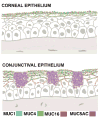The ocular surface: the challenge to enable and protect vision: the Friedenwald lecture
- PMID: 17898256
- PMCID: PMC2886589
- DOI: 10.1167/iovs.07-0770
The ocular surface: the challenge to enable and protect vision: the Friedenwald lecture
Figures








References
-
- Research in dry eye: Report of the Research Subcommittee of the International Dry Eye WorkShop in: Report of the International Dry Eye WorkShop (DEWS) Ocul Surf. 2007;5:179–193. - PubMed
-
- Williams K, Watsky M. Gap junctional communication in the human corneal endothelium and epithelium. Curr Eye Res. 2002;25:29–36. - PubMed
-
- Walcott B, Moore LC, Birzgalis A, et al. Role of gap junctions in fluid secretion of lacrimal glands. Am J Physiol Cell Physiol. 2002;282:C501–507. - PubMed
-
- Kinoshita S, Adachi W, Sotozono C, et al. Characteristics of the human ocular surface epithelium. Prog Retin Eye Res. 2001;20:639–673. - PubMed
-
- Paulsen FP, Schaudig U, Thale AB. Drainage of tears: impact on the ocular surface and lacrimal system. Ocul Surf. 2003;1:180–191. - PubMed
Publication types
MeSH terms
Substances
Grants and funding
LinkOut - more resources
Full Text Sources
Other Literature Sources

